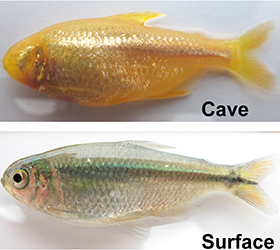
Imagine you were a fish who lived so deep in a cave that you never caught a single ray of sunshine. Would genes for functional eyes be a good fit for you?
“In a past life, I worked in Mexico,” says Suzanne McGaugh, a new faculty in the Department of Evolution, Ecology and Biology. That’s where she first plunged into her fascination with the intriguing oddities of the cavefish model system.
Ancestors to modern-day cavefish likely had eyes and pigmented bodies. Though today’s surface-dwelling cavefish retain these traits, many populations that never encounter light have pale scales and empty dents where eyes should be. Interestingly, individual populations of cavefish seem to have lost their sight in independent evolutionary events. What’s more, different populations underwent unique mutations that yielded similar phenotypic results—all without causing a final divergence into distinct species.

On the other hand, McGaugh also studies the molecular mechanisms of recombination in a variety of critters from fruit flies to cattle. She hopes to someday generate a recombination map in cavefish.
Recombination occurs within reproductive cells like eggs and sperm when chromosomes link up and swap chunks of parental DNA. Regardless of species, there are presumably underlying rules to the molecular mechanisms at play. It’s ultimately these broad patterns that McGaugh hopes to uncover.
“Understanding the location and frequency of recombination events within a genome is absolutely essential for interpreting population genetic data,” says McGaugh. “That’s how it all ties together.”
Cavefish genomes are swimming in opportunities for insight into broad evolutionary rules. Fruit fly chromosomes are buzzing with molecular behaviors. It’s just a matter of piecing together the pathways in between.
—Colleen Smith
MN Daily >> Genetics of blind cave fish lays ground for treating eye disease